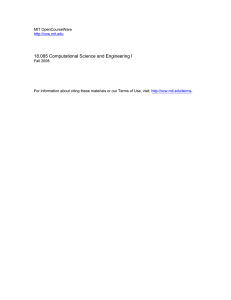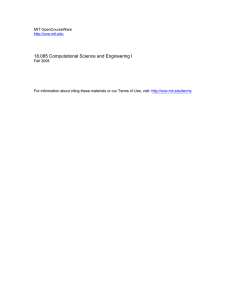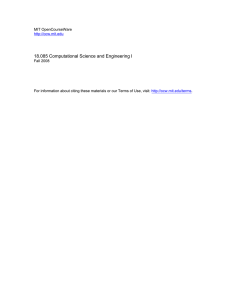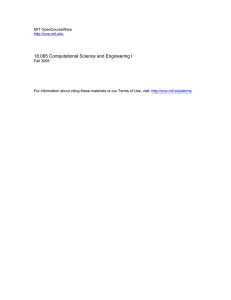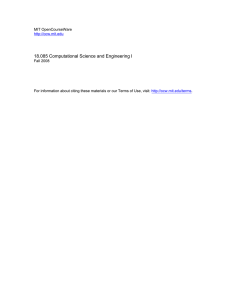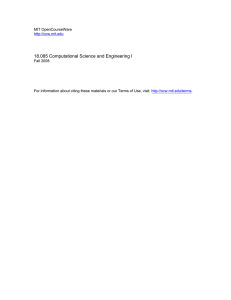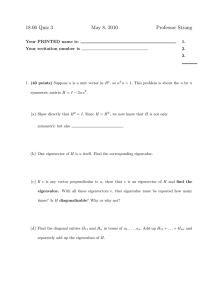18.085 Computational Science and Engineering I MIT OpenCourseWare Fall 2008
advertisement
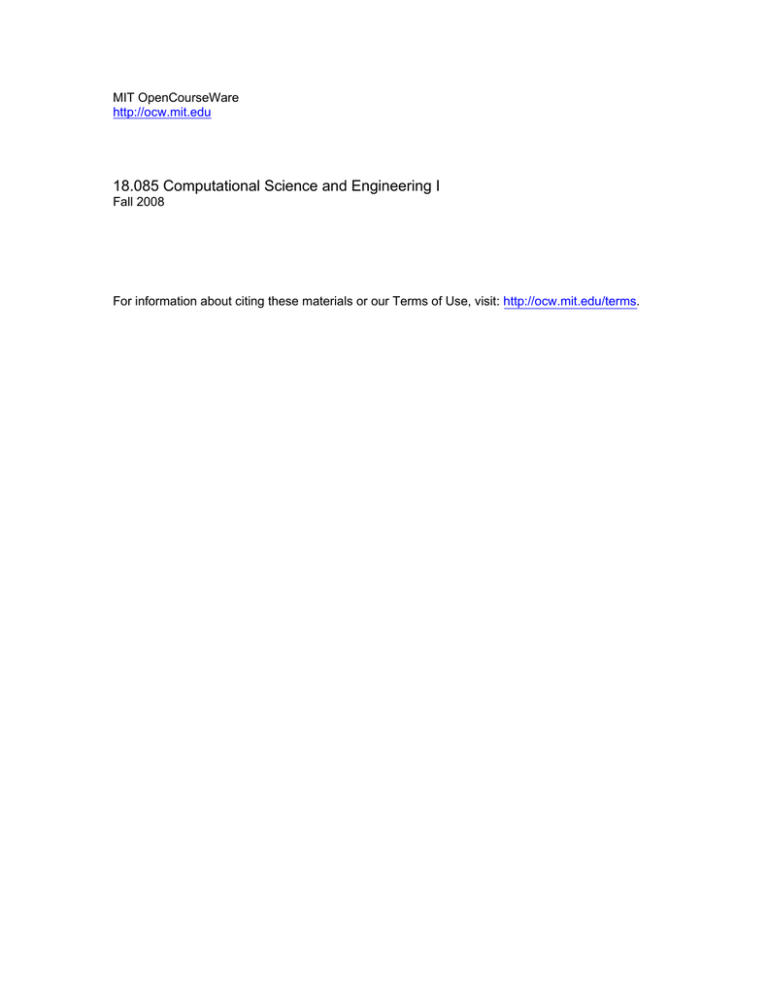
MIT OpenCourseWare http://ocw.mit.edu 18.085 Computational Science and Engineering I Fall 2008 For information about citing these materials or our Terms of Use, visit: http://ocw.mit.edu/terms. 18.085 Quiz 1 October 4, 2004 Your name is: Professor Strang SOLUTIONS Grading OPEN BOOK EXAM 1. 2. 3. 4. Write solutions onto these pages ! Circles around short answers please !! 1) (32 pts.) This problem is about the symmetric matrix ⎡ ⎤ 2 −1 0 ⎢ ⎥ ⎢ ⎥ H = ⎢ −1 2 −1 ⎥ ⎣ ⎦ 0 −1 1 (a) By elimination find the triangular L and diagonal D in H = LDLT . (b) What is the smallest number q that could replace the corner entry H33 = 1 and still leave H positive semi definite ? q = (c) H comes from the 3-step framework for a hanging line of springs: A C AT displacements −→ elongations −→ spring forces −→ external force f What are the specific matrices A and C in H = AT CA ? (d) What are the requirements on any m by n matrix A and any symmetric matrix C for AT CA to be positive definite ? ⎡ 2 −1 ⎤ ⎡ 0 2 −1 ⎤ 0 ⎢ ⎥ ⎢ ⎥ ⎢ ⎥ ⎢ ⎥ 1. ⎢ −1 −→ ⎢ 0 3/2 −1 ⎥ 2 −1 ⎥ ⎣ ⎦ ⎣ ⎦ 0 −1 1 0 0 1/3 ⎡ 1 0 ⎢ ⎢ (a) H = LDLT with L = ⎢ −1/2 1 ⎣ 0 −2/3 ⎤ ⎡ ⎥ ⎥ 0 ⎥ ⎦ 1 ⎢ ⎢ D = ⎢ ⎣ 0 ⎤ 2 ⎥ ⎥ ⎥ ⎦ 3/2 1/3 (b) If q = 23 = H33 then H is only semidefinite. ⎡ ⎤ 1 0 0 ⎢ ⎥ ⎢ ⎥ (c) A = ⎢ −1 1 0 ⎥ and C = I ⎣ ⎦ 0 −1 1 (d) A must have n independent columns (full rank n) C must be positive definite (to make AT CA pos def for all those A) 2 2) (24 pts.) Suppose we make three measurements b1 , b2 , b3 at times t1 , t2 , t3 . They would fit exactly on a straight line b = C + Dt if we could solve C + Dt1 = b1 C + Dt2 = b2 C + Dt3 = b3 . (a) If b1 , b2 , b3 are equally reliable what are the equations for the best and D ? Don’t solve the equations—write them in terms of values C t’s and b’s (not just some letter A). (b) Suppose the errors in b1 , b2 , b3 are independent with variances σ12 , σ22 , σ32 (covariances = 0 because independent). Find the new equations for and D. Use t’s, b’s and ci = 1/σ 2 —by method 1 or 2 the best C i 1 Remember how the covariance matrix Σ (called V in the book) enters the equations 2 Divide the three equations above by σ1 , σ2 , σ3 . Then do ordinary least squares because the rescaled errors have variances = 1. (c) Suppose σ1 = 1, σ2 = 1, but σ3 → ∞ so the third measurement is (exactly reliable ) (totally unreliable) CROSS OUT ONE. In this case the best straight line goes through which points ? 3 2. ⎡ ⎤ ⎡ ⎤ ⎡ ⎤ 1 t1 b ⎢ ⎥ C ⎢ 1 ⎢ ⎥ ⎢ ⎦ = ⎢ b2 (a) AT A x = AT b is ⎢ 1 t2 ⎥ ⎣ ⎣ ⎦ D ⎣ b3 1 t3 ⎥ ⎥ ⎥ ⎦ = b1 + b2 + b3 + (t1 + t2 + t3 ) D 3 C + (t2 + t2 + t2 ) D = t1 b1 + t2 b2 + t3 b3 (t1 + t2 + t3 ) C 1 2 3 (b) AT Σ−1 A x = AT Σ−1 b OR AT CA x = AT Cb with ci = 1/σi2 + (c1 t1 + c2 t2 + c3 t3 ) D = c1 b1 + c2 b2 + c3 b3 (c1 + c2 + c3 ) C + (c1 t2 + c2 t2 + c3 t2 ) D = c1 t1 b1 + c2 t2 b2 + c3 t3 b3 (c1 t1 + c2 t2 + c3 t3 ) C 1 2 3 (c) σ3 → ∞ TOTALLY UNRELIABLE The best line goes through the points (t1 , b1 ) and (t2 , b2 ) 4 3) (20 pts.) (a) Suppose du dx is approximated by a centered difference: du u(x + ∆x) − u(x − ∆x) ≈ dx 2 ∆x With equally spaced points x = h, 2h, 3h, 4h, 5h = 16 , 62, 36 , 64 , 56 and zero boundary conditions u0 = u6 = 0, write down the 3 by 3 centered first difference matrix ∆: (∆u)i = ui+1 − ui−1 . 2h Show that this matrix ∆ is singular (because 3 is odd) by solving ∆u = 0. (b) Removing the last row and column of a positive definite matrix K always leaves a positive definite matrix L. Why ? Explain using one of the tests for positive definiteness. 5 3. ⎡ 0 1 1 ⎢ ⎢ (a) ∆ = ⎢ −1 0 2h ⎣ 0 −1 (b) ⎤ 0 ⎥ ⎥ 1 ⎥ ⎦ 0 ⎡ ⎤ 1 ⎢ ⎥ ⎢ ⎥ ∆u = 0 for u = ⎢ 0 ⎥ ⎣ ⎦ 1 1. There is one less pivot and determinant to test. ⎡ ⎤ x 2. xT Lx = xT 0 K ⎣ ⎦ > 0 for x = 0 0 T 3. λmin (L) ≥ λmin (K) > 0. This important fact comes from λmin (K) = min xxTKx x the Rayleigh quotient. Physically, if you hold the last mass in place then the natural frequencies of a line of springs will (increase) (decrease), as violinists know. 6 4) (24 pts.) The equation to solve is −u + u = δ(x − 12 ) with a unit point load at x = 12 and zero boundary conditions u(0) = u(1) = 0. (a) Solve −u − u = 0 starting from x = 0 with u(0) = 0. There will be one arbitrary constant A. Replace x by 1 − x in your answer, to solve −u − u = 0 ending at u(1) = 0 with arbitrary constant B. (b) Use the “jump conditions” at x = 12 to find A and B. 7 4. ⎧ ⎨ A sin x for x ≤ 12 (a) u(x) = ⎩ B sin(1 − x) for x ≥ 1 2 (b) At x = 1 2 : Drop in slope : A sin 12 = B sin 12 so A = B A cos 12 = −B cos 12 + 1 so A = (2 cos 12 )−1 8
